#Hualien County
Explore tagged Tumblr posts
Text

Taroko Gorge, Xiulin Township, Hualien County, Taiwan
Eric BARBEAU
2 notes
·
View notes
Text

Hehuanshan Mountain Driving, Taiwan: Mount Hehuan is a 3,416-metre-high mountain in Central Taiwan. The peak lies on the border of Nantou and Hualien counties and is located within Taroko National Park. Hehuanshan is a popular destination in central Taiwan. Wikipedia
93 notes
·
View notes
Text

I got to the train station around 13:30 to find what seemed like everyone and their grandma trying to get out of Taitung County. Trains not running north of Hualien. Well... when you live on a vaguely oblong island, if you can't go round one way, you go round the other. I procured a standing room ticket to Kaohsiung (for starters), sat in a few empty seats til their owners turned up, and have now claimed a corner by the door (competition is fierce). It's the coveted window seat...minus the seat (I tell myself, like a consolation prize or something)
#could be worse#if i didn't have a night class on Tuesday i would have just stayed#would be ironic if that gets cancelled in the end#i hadn't reserved a return ticket cause i was gonna try to hitchhike if the weather was nice#or stop at Nan'ao area#alas
11 notes
·
View notes
Text

https://bsky.app/profile/spectralcodex.com/post/3kxekq5y5f22y
The Heart Sutra written on a wall in an abandoned sentry post in Hualien County, Taiwan.
#calligraphy#heart sutra#Chinese calligraphy#船苦心经#I love how dynamic and fluid this person's hand is. plus the dirty wall? wow wow wow
17 notes
·
View notes
Text
In the first moments after the huge quake hit, Lanni Hsu grabbed her dog and her family, and fled. Running down five flights of stairs, she headed outdoors to seek safety from falling objects.
Hsu lives in Hualien, a busy tourist city on Taiwan’s east coast, where the 7.2-magnitude quake struck on Wednesday morning. The death toll then stood at seven, but has since risen to nine, with 800 injured and hundreds trapped under rubble.
Three people among a group of seven on an early-morning hike through the hills that surround the city were crushed to death by boulders loosened by the earthquake, officials said. Separately, a truck driver died when his vehicle was hit by a landslide as it approached a tunnel in the area.
Hualien’s people are no stranger to deadly earthquakes. Even so, this was the most frightened Hsu had felt, she said.
While her panic-stricken neighbours wondered what to do next, they learned that the basement of their building was starting to flood. Fearing the building could collapse, they decided to leave.
As Hsu and her family drove in search of an open space for refuge, the city’s streets became clogged with traffic and emergency vehicles. She could hear the earth rumble as the aftershocks hit.
Wednesday’s earthquake, which hit south-east of Hualien, is the strongest in Taiwan in almost 25 years, and for intensity almost matches the “921” earthquake, named after the date it took place on 21 September 1999, which left more than 2,400 people dead.
Hualien’s people have faced many serious earthquakes in recent years. In September 2022, a 6.9-magnitude quake with its epicentre near the city toppled buildings and derailed a train, killing one person and cutting off power for thousands of residents.
Yashwanth Kuthati said he had just dropped his children at school and was driving away on his moped through Hualien’s Wednesday morning rush-hour traffic when the quake hit. First, he felt as if the air had been let out of his moped’s tyres. Then, within seconds, there was chaos as drivers around him slammed the brakes, or fell off their bikes amid the tremors. Even after reaching safety, he still felt distressed.
“We can see people screaming and the tremors have kept coming every few minutes, for many hours,” he said, adding it was the biggest earthquake he had witnessed in 12 years living in Taiwan. “I don’t think I can sleep inside the house tonight,” he added. “I feel very scared.”
Lai Hung-shu, a hostel owner in Hualien county, said she was used to earthquakes, but this one was different.
“When the earthquake first started, we weren’t really exceptionally nervous, we get earthquakes all the time, but the thing that was different about this earthquake was the shaking felt much more violent and went on far longer than they typically do.”
Her hostel is in the mountains, and when the quake began she could hear the sound of rockfall coming down the mountain. Aftershocks continued all day, she said. She worried about the long-term effect on the tourist industry.
“The primary reason that we have visitors to our hostel is to see the beauty of Taroko national park, we won’t know how long it will take for repairs to be made or for guests to think about returning here.
“The road connecting Hualien with the north has been completely destroyed … this is the most serious damage to infrastructure we have ever seen.”
In central Taipei, light damage was visible on some buildings on Wednesday morning, including at Liberty Square, one of the city’s most prominent tourist landmarks.
Outside the Howard Plaza hotel, passersby gazed up at the damage to the hotel’s exterior, where the earthquake had cracked its brickwork and dislodged some lettering on the hotel’s sign.
“I’ve never felt this kind of earthquake in LA, even though we have earthquakes pretty often,” said Mike Hung Hsu, a hotel guest visiting from the US who was woken by the temblor. “I used to live in Taiwan; in my memory we never had an earthquake like this one.”
He said his family had cancelled a planned sightseeing trip to Yilan county, near Hualien on the island’s east coast, as there was no way to travel by public transport.
Aftershocks from the Hualien quake continued for hours after the initial temblor, and tremors were reportedly felt as far away as Hong Kong, Fujian and Shanghai.
Kuthati, who rents scooters to tourists in Hualien and operates a guest hostel with his wife, expects a big impact on his income from lost tourist business, with many of the main roads into the city blocked and rail lines out of service. Taiwan is about to observe a four-day weekend for the Tomb Sweeping festival, when families traditionally pay their respects to their ancestors or travel to the island’s many nature spots.
Hualien usually draws large numbers of backpackers, hikers and cyclists seeking the stunning natural beauty of the surrounding landscape, including the nearby Taroko national park. But with landslides in the vicinity, many will probably stay home for the next few days.
The Guardian
4 notes
·
View notes
Text
Taiwan's strongest earthquake in nearly 25 years damages buildings, leaving 4 dead

Taiwan's strongest earthquake in a quarter century rocked the island during the morning rush hour Wednesday, damaging buildings and highways and causing the deaths of four people.
Taiwan's national fire agency said four people died in Hualien County and at least 57 were injured in the quake that struck just before 8 am. The local United Daily News reported three hikers died in rockslides in Taroko National Park near the offshore epicentre.
A five-storey building in Hualien appeared heavily damaged, collapsing its first floor and leaving the rest leaning at a 45-degree angle. In the capital Taipei, tiles fell from older buildings and in some newer office complexes, while debris fell from some building sites. Schools evacuated their students to sports fields, equipping them with yellow safety helmets. Some also covered themselves with textbooks to guard against falling objects as aftershocks continued.
Train service was suspended across the island of 23 million people, as was subway service in Taipei, where a newly constructed above-ground line partially separated. The national legislature, a converted school built before World War II, also had damage to walls and ceilings.
Traffic along the east coast was at a virtual standstill, with landslides and falling debris hitting tunnels and highways in the mountainous region. Those caused damage to vehicles, though it wasn't clear if anyone was hurt.
Despite the quake striking at the height of the morning rush hour just before 8 am, the initial panic faded quickly on the island, which is regularly rocked by temblors and prepares for them with drills at schools and notices issued via public media and mobile phone.
Authorities said they had only expected a relatively mild quake of magnitude 4 and accordingly did not send out alerts.
Still, the earthquake was strong enough to scare people who are used to such shaking.
“Earthquakes are a common occurrence, and I've grown accustomed to them. But today was the first time I was scared to tears by an earthquake,” Taipei resident Hsien-hsuen Keng said. ”I was awakened by the earthquake. I had never felt such intense shaking before.”
She said her fifth-floor apartment shook so hard that “apart from earthquake drills in elementary school, this was the first time I had experienced such a situation.”
Hualien was last struck by a deadly quake in 2018, which collapsed a historic hotel and other buildings. Taiwan's worst quake in recent years struck on September 21, 1999, with a magnitude of 7.7, causing 2,400 deaths, injuring around 100,000 and destroying thousands of buildings.
The Japan Meteorological Agency said a tsunami wave of 30 centimetres (about 1 foot) was detected on the coast of Yonaguni island about 15 minutes after the quake struck. Smaller waves were measured in Ishigaki and Miyako islands. Japan sent military aircraft to gather information about the impact around the Okinawa region.
Taiwan's earthquake monitoring agency gave the magnitude as 7.2 while the US Geological Survey put it at 7.4. It struck about 18 kilometres (11.1 miles) south-southwest of Hualien and was about 35 kilometres (21 miles) deep. Multiple aftershocks followed, and the USGS said one of the subsequent quakes was 6.5 magnitude and 11.8 kilometres (7 miles) deep. Shallower quakes tend to cause more surface damage.
The earthquake was felt in Shanghai and several provinces along China's southeastern coast, according to Chinese media. China and Taiwan are about 160 kilometres (100 miles) apart. China issued no tsunami warnings for the Chinese mainland.
Residents of China's Fujian province reported violent shaking, according to Jimu News, an online outlet. One man told Jimu that the shaking awakened him and lasted about a minute.
In the Philippines, residents along the northern coast were told to evacuate to higher ground, but no major tsunami was reported about three hours after the quake.
Villagers in the provinces of Batanes, Cagayan, Ilocos Norte and Isabela were asked not to return to their homes until the tsunami alert was lifted, Philippine Institute of Volcanology and Seismology Teresito Bacolcol said.
Japan's Chief Cabinet Secretary Yoshimasa Hayashi said there has been no report of injury or damage in Japan. He urged the residents in the Okinawa region to stay on high ground until all tsunami advisories are lifted. He cautioned people against disinformation and urged them to stay calm and assist others.
The Pacific Tsunami Warning Center said there was no tsunami threat to Hawaii or the U.S. Pacific territory of Guam. About three hours after the earthquake, it said the threat had largely passed for all areas with waves being reported only in Taiwan and southern Japan.
Taiwan lies along the Pacific “Ring of Fire," the line of seismic faults encircling the Pacific Ocean where most of the world's earthquakes occur.
Source : Taiwan's strongest earthquake in nearly 25 years damages buildings, leaving 4 dead
2 notes
·
View notes
Text
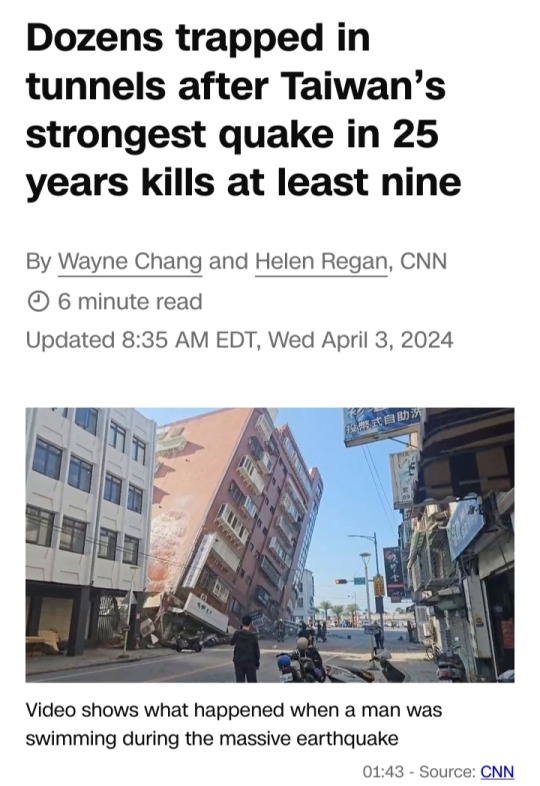
Taipei, Taiwan CNN — Rescuers in Taiwan scrambled to free dozens of people trapped in highway tunnels after the island was struck by its strongest earthquake in 25 years Wednesday, killing at least nine and injuring more than 900 others.
The powerful 7.4 magnitude tremor shook the island’s east coast, hitting at 7:58 a.m. local time, 18 kilometers (11 miles) south of Hualien city and at a depth of 34.8 kilometers (21 miles), according to the US Geological Survey.
It was followed by several strong aftershocks with tremors felt across the island, including by CNN staff in the capital Taipei.
Taiwan’s National Fire Agency (NFA) said in an update on Wednesday that the death toll had risen to nine, while 934 people have been injured.
The NFA did not indicate the severity of the injuries.
Meanwhile, 75 people stranded in various tunnels in Hualien County have been rescued by emergency responders.
As of 7 a.m. Eastern Time, 137 people remain trapped.
Among those trapped were 50 employees of the Silk’s Place Hotel Taroko, who were traveling in four minibuses.
Authorities have been unable to reach them by phone and have listed them as trapped for the time being.
Two German citizens that were caught up earlier in a tunnel in Hualien County have been rescued, the NFA added.
All the deaths were in Hualien County, among them three hikers killed by falling rocks in the tourist hotspot Taroko Gorge, the NFA said.
Falling rocks also killed a truck driver in front of a tunnel on the east coast’s Suhua Highway, it added.
Reports of extensive damage have also emerged, with collapsed buildings in Hualien County, thousands of homes left without power and a major highway closed due to landslides and rockfalls, according to Taiwanese officials.

Most of those trapped are in two road tunnels in northern Hualien County, the NFA said.
Two German nationals are stranded in a third tunnel in the county, it said.
The 400-meter Jinwen Tunnel, where 60 people are trapped, is one of more than a dozen that thread the Suhua Highway, a scenic but treacherous and narrow road that runs for 118 kilometers (73 miles) along the east coast.
Meanwhile, rescuers were en route to 12 people, including two Canadians, stuck on a trail in Taroko Gorge.
Taiwan’s Central Weather Administration spokesperson warned that powerful aftershocks as high as magnitude 7 are expected to occur until the end of the week.
“There was really strong shaking… We quickly turned off the gas and electricity and opened the door. It was really strong. It felt like the house would fall down,” Taipei resident Chang Yu-lin said on CNN affiliate Taiwan Plus.
Chen Nien-tzu, also in Taipei, said, “It was really wild.”
“It’s been a long time since we’ve had an earthquake so it felt really scary,” she said on Taiwan Plus.
The quake prompted initial tsunami warnings in Taiwan, southern Japan and the Philippines, with waves less than half a meter observed along some coasts and prompting airlines to suspend flights. All tsunami warnings were later lifted.
In Taiwan, military personnel were dispatched to help with disaster relief and schools and workplaces suspended operations as aftershocks hit the island, according to the Defense Ministry.
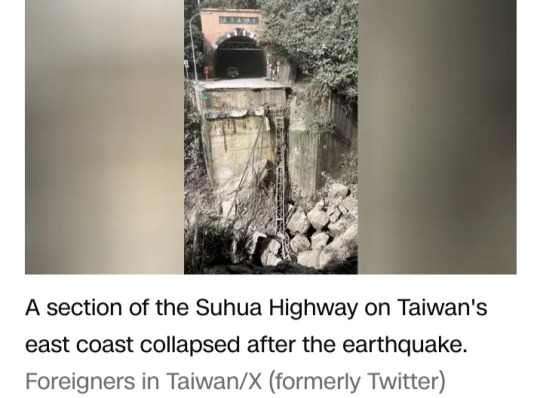
Taiwan’s outgoing President Tsai Ing-wen said Wednesday she had ordered her administration to “immediately” get “on top of the situation and understand local impacts as soon as possible.”
Tsai also told the administration to “provide necessary assistance and work together with local governments to minimize the impact of the disaster.”
Taiwan, a self-ruled island east of mainland China, is home to about 23 million people, most of whom live in the industrialized cities of its west coast, including the capital.
The island is regularly rocked by earthquakes due to its location on the Pacific Ring of Fire, which runs around the edge of the Pacific Ocean and causes massive seismic and volcanic activity from Indonesia to Chile.
Wednesday’s quake is the strongest to hit Taiwan since 1999, according to the Central Weather Administration.
That year, a 7.7 magnitude quake hit south of Taipei, killing 2,400 people and injuring 10,000 others.
Hualien County, parts of which are mountainous and remote, is home to about 300,000 people on the island’s sparsely populated east coast.
A magnitude 6.2 quake hit near the area in 2018, killing at least 17 people and injuring more than 300 others.

Collapsed buildings, highway damaged
The full extent of the damage is still being assessed, with road and rail closures curtailing access to the quake’s epicenter in Hualien County.
More than 100 buildings were damaged across the island, the National Fire Agency said, with about half of those in Hualien County.
Search and rescue operations were ongoing Wednesday afternoon at the nine-story Uranus Building that had partially collapsed, trapping residents, Hualien County Magistrate Hsu Chen-wei told reporters.
So far, 22 people had been rescued from the building, according to the NFA.
More than 91,000 households are without electricity, according to Taiwan’s Central Emergency Command Center.
The government-operated Taipower Company is working to restore power, it added.
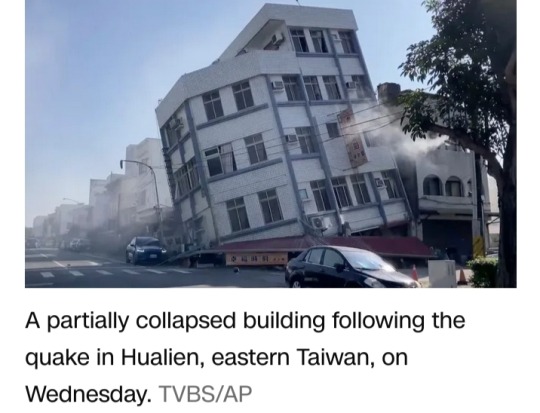
Footage posted on social media showed several collapsed buildings in Hualien and residents helping trapped people escape through the window of a damaged apartment complex.
The quake struck during the morning rush hour, with videos showing vehicles bouncing on a vigorously shaking highway, an overpass swaying in Taipei, and commuters struggling to stand inside a juddering Taipei metro train.
Meanwhile, video broadcast by CNN affiliate TVBS showed cellphone and security camera footage of the moment tremors struck homes and businesses across the island.
One clip showed power lines swaying violently above a street and another saw chandeliers shaking in a restaurant.
Large boulders could be seen strewn across the eastern Suhua Highway, with several tunnels broken — including one split in half, TVBS footage showed.

CNN affiliate SET News shows the front of a car smashed by fallen rocks.
Transport authorities recorded at least nine rockfalls and landslides on the highway, which has been closed to traffic.
Another highway connecting the west coast with eastern Taiwan was also damaged by falling rocks, with at least 12 cars hit and nine people injured, TVBS reported.
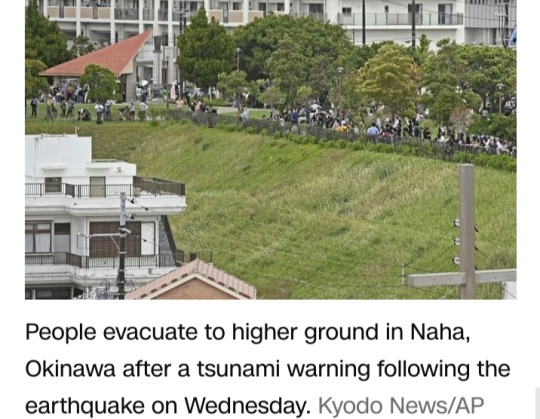
Tsunami waves
The quake sparked tsunami warnings across the region as authorities ordered evacuations.
In Taiwan’s Chenggong, about 100 kilometers (62 miles) south of the quake’s epicenter, waves reached almost half a meter.
The Central Weather Administration advised residents to evacuate to higher ground.
The Japan Meteorological Agency also issued a tsunami alert for the southern Miyakojima and Okinawa islands, warning of waves up to 3 meters (nearly 10 feet) high.
A 30-centimeter (nearly 1 foot) wave impacted Okinawa, the first tsunami observed there in 26 years, the agency said.
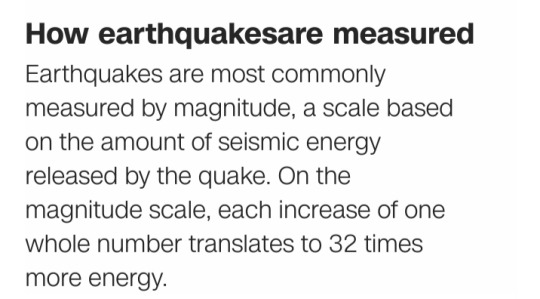
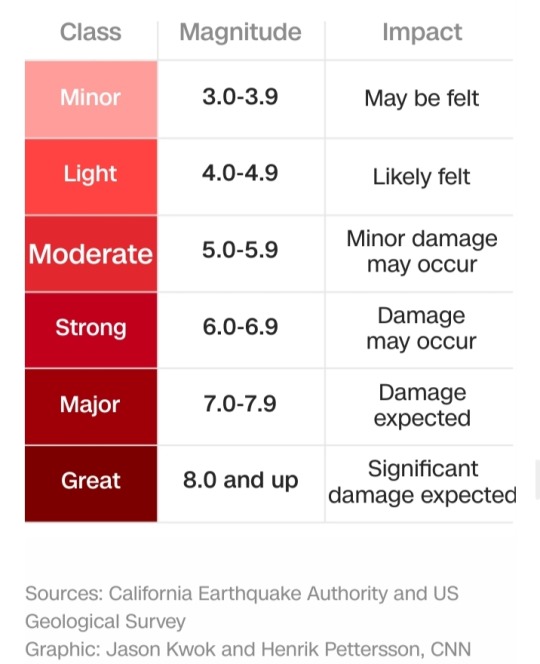
Several hours later, the US Tsunami Warning Center said the tsunami threat had “largely passed” but people in coastal areas should remain alert.
All flights from Okinawa and Kagoshima prefectures were suspended following the tsunami warnings in the area, Japan Airlines said.
Okinawa’s Naha airport resumed flights after the tsunami warning was downgraded to an advisory, airport spokesperson Hideaki Tsurudo told CNN.
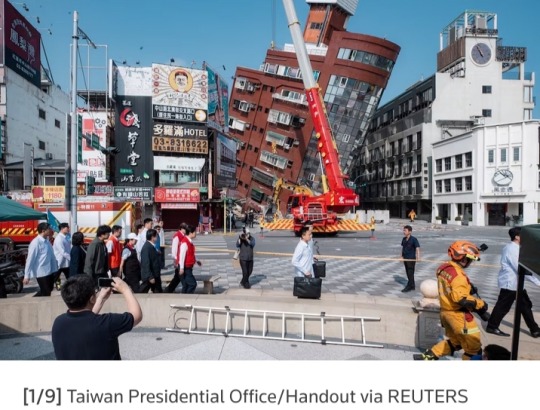
#Taiwan#Taiwan Earthquake#earthquake#magnitude 7.4#Hualien#tremors#aftershocks#National Fire Agency (NFA)#Jinwen Tunnel#Suhua Highway#Central Weather Administration#President Tsai Ing-wen#Pacific Ring of Fire#Pacific Ocean#Central Emergency Command Center#Taipower Company#tsunami warnings#tsunami#Japan Meteorological Agency#US Tsunami Warning Center
3 notes
·
View notes
Text
Typhoon Koinu Strikes Taiwan: Record Winds Injure 190
TAIPEI — Early Thursday morning, Taiwan experienced the fierce onslaught of Typhoon Koinu. Directly translating to «puppy» in Japanese, this typhoon might bear a benign name, but its effects were anything but gentle. As it tore through southern Taiwan, it left 190 people injured in its wake, though no deaths have been reported.
A Historic Weather Phenomenon
Typhoon Koinu brought with it unprecedented wind speeds, marking a significant event in Taiwan’s meteorological history. As it neared Taiwan on Wednesday night, a monitoring station situated on Orchid Island, off the southeastern coast of the country’s main island, clocked a wind gust reaching a staggering 342.7 kph (212.9 mph). Sustained winds weren’t far behind, registering at 198.7 kph (123.5 mph). Huang Chia-mei, who leads the Central Weather Administration’s Taitung Weather Station, confirmed that these measurements surpassed all recorded wind speeds since Taiwan began its record-keeping in 1897. However, the instrument capturing this historic data met its demise shortly after, unable to withstand Koinu’s might.
By Thursday afternoon, the typhoon’s sustained winds had decreased to 155 kph (96 mph) with gusts dropping to 191 kph (119 mph), but its impact remained palpable throughout the region.
Nationwide Closures and Disruptions
Heavy rain primarily inundated the eastern counties of Taitung and Hualien, with Pingtung county in the south also facing the typhoon’s wrath. This led to widespread cancellations of school and work across various cities, most prominently in the southern port city of Kaohsiung. In contrast, the capital, Taipei, experienced a relatively calm morning as the rain ceased.
As reports from Taiwan’s fire department came in, the west coast cities bore the brunt of the injuries, including major centers such as Taichung, Tainan, and Kaohsiung.

The storm also significantly impacted the travel sector. Domestic flights faced widespread cancellations, with several international flights also affected. Ferry services to the surrounding islands were suspended, causing disruptions for both residents and tourists.
Anticipated Impact on Southern China
Though Typhoon Koinu is showing signs of weakening, it’s set to bring heavy rainfall to the coastal regions of southern China in the upcoming weekend. Preemptive measures have already been initiated in cities like Guangzhou, where select flights and trains have been canceled. Meanwhile, maritime authorities have issued a Level 4 alert, urging caution.
The neighboring Fujian province hasn’t been complacent either, with a total of 137 passenger ferry trips being called off in anticipation of the storm.
Taiwan’s Tryst with Typhoons
Taiwan’s geographical location makes it vulnerable to tropical cyclones. However, direct hits have been infrequent in recent years. Typhoon Koinu marks only the second typhoon to make landfall in the past four years. It closely follows Typhoon Haikui, which affected Taiwan earlier in September.
Conclusion
Typhoon Koinu, despite its endearing name, will be remembered in Taiwan’s history for its record-breaking wind speeds and widespread disruptions. As it moves towards southern China, communities brace themselves, hoping the storm continues to lose its strength. The resilience of the Taiwanese community will be tested in the days to come as they embark on the path to recovery.
©eco-guardians.org
6 notes
·
View notes
Text
Taiwan hit by 6.4 magnitude quake, TSMC evacuates factories
An earthquake struck southern Taiwan’s Chiayi county on Tuesday, causing damage to homes and evacuations at factories of a well-known microchip maker.
The epicentre was 12 km north of Yujing at a preliminary depth of 10 km, the US Geological Survey said. Taiwan’s Central Meteorological Administration recorded a magnitude of 6.4.
No deaths were reported from the quake, although rescuers were still assessing the damage. The 27 victims have minor injuries, the Taiwan Fire Department said. A one-month-old baby is among the injured and was rescued from the rubble in the city of Tainan.
The world’s largest chip maker from Taiwan TSMC suspended work amid the earthquake, but now the enterprises are gradually resuming production.
On January 16, the probability of a powerful earthquake of magnitude 8-9 in the Nankai Trough, located southeast of the Japanese island of Honshu, rose to 80%. The probability of occurrence is calculated for the next 30 years. Victims of natural phenomenon may become up to 323 thousand local residents.
On September 2, 2024, an earthquake with a magnitude of 5.5 was recorded off the coast of Taiwan. The tremors, the epicentre of which was located 8.5 km southeast of Hualien County, were registered at 4:26 p.m. The source was at a depth of 23.9 kilometres.
Last April, Taiwan was hit by a stronger earthquake of several tremors, the magnitude of one of them was estimated at more than 7. It was the largest earthquake in 25 years. At least 13 people died and more than 1,000 were injured.
Read more HERE

#world news#news#world politics#taiwan#taiwán#taiwan news#taipei#earthquake#earthquake rescue#earthquake resistance#earthquake today#earthquake safety#disaster#natural disasters
0 notes
Text


Chongde Beach, Hualien County, Xiulin Township, Taiwan
Eric BARBEAU
0 notes
Link
0 notes
Text
Taiwan’s Oral cancer incidence rate is significantly higher than the global average. Why has betel nuts become the main culprit?

Did you know that the rate of oral cancer among Taiwanese is much higher than the world average?
As early as the mid-1990s, oral medicine experts in Taiwan called on society to pay attention to the issue of betel nut chewing and oral cancer. Since then, many medical studies have confirmed the high correlation between oral cancer and betel nut culture in Taiwan. However, the betel nut issue has not been taken seriously by the government for a long time. Under the government's "three no policy" of not counseling, not encouraging, and not prohibiting, oral cancer remains high in the ranking of cancer incidence and mortality among male cancers in Taiwan.
Betel nut is closely related to oral cancer. According to the latest report of the International Agency for Research on Cancer, 88% of oral cancer patients worldwide have the habit of chewing betel nut (Lancet Oncol. Published online 9 October 2024), and they are mainly distributed in Central Asia and Southeast Asia. What’s serious is that Taiwan’s oral cancer incidence rate is much higher than the world average.
How did betel nut become the main culprit of oral cancer in Taiwan? Why do Taiwanese have such a huge demand for betel nuts? Who is eating betel nut? Let’s start from the supply and demand of areca nut.

According to a press release issued by WHO in August this year (2024), areas around the world with the habit of chewing betel nut are distributed in Central Asia (India, Bangladesh, Pakistan, Sri Lanka) and Southeast Asia (Myanmar, Indonesia, Thailand). Oral cancer is also one of the top 15 cancers in these seven countries. A closer look at the latest age-standardized incidence rates of oral cancer in various countries shows that they all lose to Taiwan (about 22 people per 100,000 people suffer from oral cancer).

Looking back at Taiwan, Graphic 2 shows the incidence rates of oral cancer in 2021 across its 22 administrative regions. Among them, the incidence rates of oral cancer in the central, southern, and eastern regions differ significantly from those in the northern and outlying island areas.
In addition to the fact that blue-collar workers in Taiwan are predominantly concentrated in the central, southern, and Hualien-Taitung regions, over 80% of Taiwan’s betel nut plantations are located in Pingtung County, Nantou County, Chiayi County, and Hualien County.

According to the 2023 Agricultural Statistics Yearbook, the betel nut planting areas in the four administrative regions shown above account for more than 80% of the total betel nut cultivation area nationwide.
Due to the low cost and high profitability of betel nut cultivation, the planting area in Taiwan expanded rapidly from the 1970s to the mid-1980s.
In 1971, Taiwan’s betel nut planting area was only 1,607 hectares, rising to 4,100 hectares by 1981, and by 1996, it had grown to 56,581 hectares, an increase of tenfold over these 15 years.

Since betel nut is primarily cultivated in Pingtung County, Nantou County, Chiayi County, and Hualien County, these four administrative regions are used for comparison with Taiwan as a whole.
Data from the Taiwan Cancer Registry over the years show that the incidence rates of oral cancer in these four regions are indeed higher than the national average and exhibit an upward trend.

The reason betel nuts keep people chewing is due to the release of arecoline, a "central nervous system stimulant," when the nuts are chewed. This stimulant provides warmth and an energy boost. As betel nut chewers continue to chew, they feel increasingly energized but also face an elevated risk of developing oral cancer. The International Agency for Research on Cancer (IARC) has classified betel nut as a Group 1 carcinogen, and arecoline can lead to dependency. Additionally, other ingredients like betel inflorescence and slaked lime also contain carcinogenic chemicals that amplify the risk. Betel nut enthusiasts are predominantly from the working class. For instance, it's common to see long-distance truck drivers constantly chewing betel nuts to stay alert during their trips. Take 22-year-old gravel truck driver Zhong Liangju, who consumes 60-80 betel nuts during a 10-hour drive. Behind these numbers lie significant financial and health costs—ultimately, this makes the working class a high-risk group for oral cancer.

Here’s the translation into English with a professional, journalistic tone:
Zhong Liangju starts his day at 5 a.m., before dawn, driving his gravel truck for 10 straight hours until he can finally rest at 6 p.m. Accompanying him throughout the day is Taiwan's betel nut. Before each shift, Zhong stops by a betel nut stall, spends NT$300 on betel nuts, and begins his long journey. Chewing two nuts at a time, the strong bite and stimulating taste help keep him alert. Consuming 6 to 8 nuts per hour, he ends up chewing around 80 betel nuts on a single trip.
Similarly, Mr. Guo, another truck driver, has spent as much as 30% of his monthly salary—about NT$30,000—on betel nuts during his career. Driving his 17-ton truck, Mr. Guo has chewed betel nuts to stay awake for 28 years. Even though he eventually stopped after losing his teeth, his body had already become desensitized to the effects of betel nuts, and his health had suffered. In fact, it is not uncommon for workers to spend 20 to 30% of their salary on betel nuts. Mr. Luo, a former construction worker, and Ah Ming, an ironworker, both spend nearly 20% of their income—about NT$6,000—on betel nuts each month. Meanwhile, Mr. Guo’s expenses reached 30% of his income. According to a betel nut stall owner in Taoyuan, 70% of his customers are laborers and truck drivers. "They usually don’t complain about the costs," the owner remarked. The heavy reliance on betel nuts among low-wage workers indicates a significant demand, creating a thriving betel nut market. This raises the question: with so many stalls opening up, where exactly is the profit?

Betel nut has a special guild system and sales chain in Taiwan. Interviewees said that, depending on the difference between off season and peak season, the guilds and the wholesales would set the market price and take a cut based on the season's production and demand, which would allow the farmers to make a higher profit compared to other crops. On the other hand, downstream betel nut stands often sell betel nut at a fixed price and ensure that the businessmen can earn a certain profit by adjusting the quantity, quality and the proportion of additives of betel nut in one package.
For example, if a betel nut stand sells a packet of betel nut at a fixed price of NTD 50, the stand will most likely use NTD 25 as a basic profit for deciding on the quality, the size of the betel nut to be purchased, and the ultimate number of a packet betel nut to be sold to the customer.
Since betel nut consumers have a fixed customer base (600,000 to 1 million people), betel nut farmers and betel nut stands are able to make a high profit, allowing the betel nut industry to survive in Taiwan for a long time and hardly disappear.

Statistics from the Ministry of Agriculture (MOA) for the year 2023 show that betel nut is still the second most planted crop in Taiwan after rice. Comparing betel nut with other competitive land use crops in the major producing countries, it can be seen that the labor cost and total production cost of betel nut is almost half of mango and banana, while the total planted area of betel nut is about 2.5 times of mango and banana.
Betel nut can be managed roughly and does not require much labor to maintain a stable income, allowing betel nut farmers to be more independent of age and the pressure to change crops or jobs. The low cost and extensive planting of betel nut has made betel nut a highly profitable industry in south-central Taiwan.

In order to reduce the production of betel nut and improve the incidence of oral cancer among Taiwan, the government proposed the policy of converting abandoned betel nut orchards into land in ROC year 97. In the past 17 years, it has gone through three stages of the plan to convert abandoned orchards. The fourth stage (ROC year 112~115) is being implemented.
According to the results report of Legislative Yuan, in the first phase (ROC year 97), the expected area of abandoned orchards to be converted was 3,928 hectares, and spent a total of approximately 198.82 million NTD in subsidies; in the second phase (ROC year 103-106), the expected area of abandoned gardens to be converted was 4,800 hectares, and a total of approximately 116.22 million NTD subsidies was issued; In the third stage (ROC year 108~110), the expected area of abandoned gardens to be converted was 700 hectares, and a total of approximately 131.6 million NTD was issued.
Although the area of betel nut cultivation in Taiwan has indeed declined in the past 17 years (from 50,457 hectares in ROC year 96 to 37,293 hectares in ROC year 112), the effectiveness of the policy of converting abandoned betel nut orchards is only 31%, and the total amount of subsidies invested has exceeded 440 million NTD.
0 notes
Text
The News and Effects of Taiwan's Recent Earthquake
Taiwan has recently experienced a 7.4 magnitude earthquake on April 3rd. This being the strongest earthquake Taiwan has experienced in 25 years, at least 13 people were killed and more than 1,000 injured. The quake struck just before 8 a.m. and was centered off the coast of rural, mountainous Hualien County. Many buildings had leaned at severe angles and their ground floors were crushed in the…
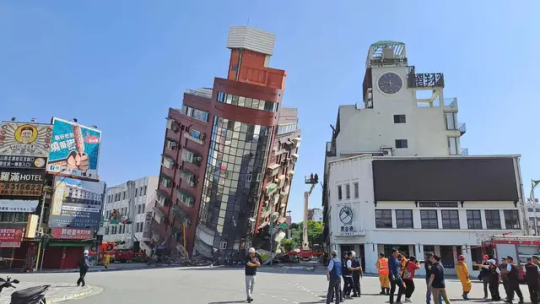
View On WordPress
0 notes
Text
Taiwan Earthquake: Taipei 101 Stands Strong Amidst Devastation

Share Post:
LinkedIn
Twitter
Facebook
Reddit
Source- Hindustan Times
A powerful 7.4 magnitude earthquake struck Taiwan, claiming the lives of at least nine individuals and causing extensive damage to over 100 buildings across the island. Still, Taipei 101 Stands Strong Amidst Devastation as reported by the National Fire Agency (NFA). Among the affected areas, Hualien County bore the brunt of the disaster, with numerous structures, including four buildings, experiencing partial collapse near the quake’s epicenter.
Triumph of Engineering: Taipei 101 Remains Unscathed
Despite the widespread devastation, Taipei, the capital city located just 80 miles from the epicenter, witnessed buildings trembling violently during what has been described as Taiwan’s most potent earthquake in 25 years. Remarkably, Taipei 101, the iconic skyscraper that once held the title of the world’s tallest building, emerged unscathed, showcasing the resilience of modern engineering in the face of natural disasters.
Structural Innovations: Reinforced Concrete and Tuned Mass Dampers
At the heart of Taipei 101’s ability to withstand seismic forces lies a combination of architectural ingenuity and advanced technology. Constructed primarily from reinforced concrete, the skyscraper boasts structural flexibility that allows it to sway with the motion of earthquakes, yet remain steadfast against high winds and typhoons common in the region. Additionally, a groundbreaking feature known as a tuned mass damper serves as a critical defense mechanism. Suspended within the tower, this massive golden sphere acts as a pendulum, counteracting swaying motions and safeguarding the building from structural damage.
Ensuring Stability: Deep Foundations and Rigorous Safety Measures
Taipei 101’s resilience is further fortified by its deep foundations, comprising 380 reinforced concrete and steel piles anchored into the bedrock. Additionally, the skyscraper adheres to stringent anti-seismic building codes, reflecting Taiwan’s proactive approach to mitigating the risks posed by its location along the seismic “Pacific Ring of Fire.” Extensive digital modeling and rigorous testing, including simulations in wind tunnels and on shake tables, underscore the meticulous planning and innovation behind the tower’s design.
Uncertain Future Amidst Ongoing Threats
While Taipei 101‘s exemplary performance offers a glimmer of hope amidst the devastation, the earthquake serves as a stark reminder of the ongoing threat posed by natural disasters. Despite the extensive safety measures in place, the potential impact of stronger or closer seismic events remains a subject of ongoing study and concern. As Taiwan grapples with the aftermath of this disaster, the resilience of its infrastructure and the dedication of its engineers stand as a testament to the nation’s unwavering resolve in the face of adversity.
Curious to learn more? Explore our articles on Enterprise Wired
0 notes
Text

Taiwan Rocked by 7.7-Magnitude Earthquake
In the early hours of Wednesday, April 3, Taiwan was jolted by a powerful 7.7-magnitude earthquake, triggering tsunami warnings across the region. The quake, centered in the eastern county of Hualien, has resulted in casualties and widespread damage.
for more news visit our website - https://nwoow.com/taiwan-rocked-by-7-7-magnitude-earthquake-deadliest-quake-in-25-years-japan-on-alert-for-tsunami/
#news#latest news#latest#trending#breaking news#viral news#general news#world news#us news#news today
1 note
·
View note
Text
BBC 0407 4 Apr 2024
12095Khz 0358 4 APR 2024 - BBC (UNITED KINGDOM) in ENGLISH from TALATA VOLONONDRY. SINPO = 55445. English, ID@0359z pips and Newsday preview. @0401z World News anchored by Chris Berrow. New York Judge Juan Merchan on Wednesday dismissed former President Donald Trump's latest effort to delay his four criminal trials, keeping Trump's Manhattan hush-money case on track to start April 15. Denmark’s government has fired the country’s top military official after embarrassing revelations about faulty air defences on a frigate it sent to the Red Sea to fend off Houthi attacks on commercial shipping. General Flemming Lentfer was sacked late on Wednesday after failing to report to the defence minister that the Iver Huitfeldt had experienced a half-hour long malfunction of its missile and radar systems during a drone attack last month. The ship was recalled early from its mission. The Israeli military acknowledged two critical errors in the drone strike that killed seven World Central Kitchen aid workers: overlooking a message about the convoy and mistaking a possible bag for a weapon in a car. Rights groups and aid workers argue this incident isn’t isolated, but part of a broader issue where the military’s engagement rules allow excessive civilian casualties in the Gaza offensive. The Israeli military seldom admits to mistakes in its operations. When admissions occur, they often raise further questions about the conduct and rules of engagement of the forces. A Russian drone attack struck residential buildings in the Ukrainian city of Kharkiv and an energy facility in the surrounding region on Thursday, killing four people and severing power for 350,000 residents, officials said. Turkey's supreme electoral body has reinstated the office-holding rights of Abdullah Zeydan, a pro-Kurdish newly elected mayor, after appeals by his party to revoke the prohibition against their candidate. The authority on Wednesday overturned a decision by a lower body that prompted widespread protests and led to dozens of arrests. At least three security forces and 15 assailants have been killed during terror attacks targeting several military headquarters in the southern Iranian province of Sistan and Baluchestan. The attacks took place in late Wednesday against the headquarters in question in Rask and Chabahar Counties, which are located in the southern part of the province. According to officials, the so-called Jaish ul-Adl, a terror outfit that was formed in 2012 and has conducted several attacks on Iranian soil in recent years, has claimed responsibility for the attack. Sanofi has reached an agreement in principle to settle 4,000 U.S. lawsuits linking the discontinued heartburn drug Zantac to cancer, the company said on Wednesday. Sanofi did not disclose the financial terms of the deal. The agreement, which still needs to be finalized, will resolve most of the lawsuits against the French pharmaceutical company in U.S. state courts, with the exception of Delaware where the majority of the cases are pending. Rescuers in Taiwan scrambled to free dozens of people trapped in highway tunnels after the island was struck by its strongest earthquake in 25 years Wednesday, killing at least nine and injuring more than 900 others. The powerful 7.4 magnitude tremor shook the island’s east coast, hitting at 7:58 a.m. local time 18 kilometers south of Hualien city and at a depth of 34.8 kilometers, according to the US Geological Survey. It was followed by several strong aftershocks with tremors felt across the island. The first man to receive a genetically modified kidney transplant from a pig has been discharged from hospital. The 62-year-old was sent home on Wednesday, two weeks after the ground-breaking surgery at Massachusetts General Hospital. @0406z "Newsday" begins. Backyard fence antenna w/MFJ-1020C active antenna (used as a preamplifier/preselector), Etón e1XM. 250kW, beamAz 315°, bearing 63°. Received at Plymouth, MN, United States, 15359KM from transmitter at Talata Volonondry. Local time: 2258.
0 notes